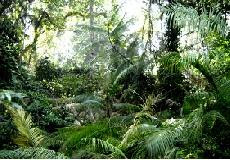Alas Purwo National Park is situated on Blambangan Peninsula in Banyuwangi regency, at the southeastern tip of East Java province. Alas means forest or jungle and Purwo means the beginning of everything.
Alas Purwo National Park is representative of a typical lowland tropical rain forest ecosystem in Java. Peculiar and endemic species of plant that grow in this Park include sawo kecik (Manilkara kauki) and manggong bamboo (Gigantochloa manggong). Among the other plants that can be found here are ketapang (Terminalia cattapa), nyamplung (Calophyllum inophyllum), kepuh (Sterculia foetida), and keben (Barringtonia asiatica). Moreover, there are 13 different species of bamboo.
 Alas Purwo National Park is a habitat for several species of wildlife such as the ebony leaf monkey (Trachypithecus auratus auratus), banteng (Bos javanicus javanicus), Asian wild dog (Cuon alpinus javanicus), green peafowl (Pavo muticus), red junglefowl (Gallus gallus), deer (Cervus timorensis russa), panther (Panthera pardus), and leopard cat (Prionailurus bengalensis javanensis). Some species of turtle like the Pacific ridley (Lepidochelys olivacea), leatherback (Dermochelys coriacea), hawksbill (Eretmochelys imbricata), and common green (Chelonia mydas) are often seen landing on the southern beach of this Park between January and November.
Alas Purwo National Park is a habitat for several species of wildlife such as the ebony leaf monkey (Trachypithecus auratus auratus), banteng (Bos javanicus javanicus), Asian wild dog (Cuon alpinus javanicus), green peafowl (Pavo muticus), red junglefowl (Gallus gallus), deer (Cervus timorensis russa), panther (Panthera pardus), and leopard cat (Prionailurus bengalensis javanensis). Some species of turtle like the Pacific ridley (Lepidochelys olivacea), leatherback (Dermochelys coriacea), hawksbill (Eretmochelys imbricata), and common green (Chelonia mydas) are often seen landing on the southern beach of this Park between January and November.In the period from October to December, some 16 species of migrant bird from Australia such as the sacred kingfisher (Halcyon chloris/Todirhampus sanctus), blue-tailed bee-eater (Merops philippinus), common sandpiper (Actitis hypoleucos), and wood sandpiper (Tringa glareola) can be seen in Bedul Segoro Anak.
Plengkung, in the southern part of the Park, is almost legendary among the world's top surfers. They call it "G-Land". The name is derived from its location in Teluk Grajagan (Grajagan Bay), which resembles the letter "G". Moreover, it is located a short distance from a stretch of tropical rain forest which always looks green (hence green land or "G-land"). Plengkung is one of the top four locations for surfing in the world and can be ranked alongside surf sites in Hawaii, Australia, and South Africa.
Walking along the white sand beach from Trianggulasi to Plengkung, visitors will come across an area of buckshot-like sand. The grains are yellow in colour and have a diameter of around 2.5 mm.
The communities living around the Park are very typical of the "Blambangan" culture. They believe that what is now the Park was the last stopover of the Majapahit people who were escaping the onslaught of the Mataram kingdom, and they are convinced that hidden somewhere in the park is a sacred kris, or dagger, named "Keris Pusaka Sumelang Gandring". For this reason, it is not unusual for people to meditate or hold religious ceremonies in the Park, particularly in Goa Padepokan and Goa Istana.
Near the Rowobendo entrance gate there are historical remains in the form of "Pura Agung", a Hindu temple, where a Hindu ceremony, "Pagerwesi", is held every 210 days.
This Park has a diversity of ecotourism and cultural tourism attractions (sea, sand, sun, forest, wild animals and traditional cultures) which are located in close proximity to one another. [source : Alas Purwo]
See The Beauty







Thanks for this very interesting arcticle. Never heard about Alas Purwo before. I will browse a bit to your blog and Google+ it. Maybe you want to visit my online travel guide at www.indonesia-travel.lestariweb.com
ReplyDeleteThis comment has been removed by the author.
ReplyDelete